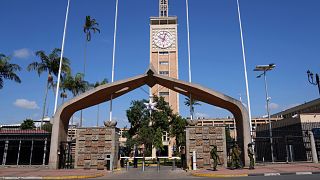Kenya
With dismay etched across her face, Martha Waema, alongside her husband, survey their three-acre farm that has been left submerged following weeks of relentless rainfall across Kenya.
Water levels would rise to shoulder height after only a night of heavy downpour on different days in April rendering the farm inaccessible.
Waema was expecting a return of 200,000 shillings ($1,500) after investing 80,000 shillings ($613) in maize, peas, cabbages, tomatoes, and kale.
But her hopes have now been dashed.
“I have been farming for 38 years, but I have never encountered losses of this magnitude. This is the most devastating level of loss I’ve ever witnessed,” says the 62-year-old mother of ten.
The loss threatens their financial security as well as stability and sense of optimism.
The rains that started in mid-March have posed immediate dangers and left others to come.
They have killed nearly 300 people, left dams at historically high levels and led the government to order residents to evacuate flood-prone areas — and bulldoze the homes of those who don't.
Now a food security crisis lies ahead, along with even higher prices in a country whose president had sought to make agriculture an even greater engine of the economy.
Kenya's government says the flooding has destroyed crops on more than 168,000 acres (67,987 hectares) of land.
This represents 0.24 percent of Kenya’s based on World Bank Data that shows 48 percent of Kenya’s land is agricultural.
As farmers count their losses, the deluge has exposed Kenya’s ill preparedness for disasters, emphasizing the need for sustainable land management and improved forecasting.
Waema now digs trenches in an effort to protect what's left of the farm on a plain in the farthest outskirts of the capital, Nairobi, in Machakos County.
About 200 kilometers west of Waema’s farm, 65-year-old farmer James Tobiko Tipis and his 16-acre farm have escaped the flooding in Olokirikirai.
He says he had been proactive in the area that's prone to landslides by terracing crops. “We used to lose topsoil and whatever we were planting."
Experts say that in order to alleviate the negative impacts of soil erosion and flooding, it's crucial to practice sustainable land management.
Jane Kirui, an agricultural officer in Narok County Government, emphasizes the of terracing and other measures such as cover crops that will allow water to be absorbed.
“We advise farmers to do the grass stripped in their farm and also cover crops and also terracing. So, cover crops will allow the water to infiltrate into the ground letting no run off in the farm which may cause erosion,” she says.
At Jomo Kenyatta University of Agriculture & Technology, John Gathenya, a hydrologist and Professor of Agricultural Engineering, recommends practices such as diversifying crops and utilizing the soil's natural water retention capacity.
“The soil remains the biggest reservoir for water, and it is equally distributed all over and that is a good thing. So, every one cubic meter of soil has the potential to store about 45 percent water if it is saturated, so basically we are talking about any volume of soil that has about half of it as storage and the more organic matter you have, the better the storage,” he explains.
Gathenya stresses the need to limit deforestation and use soil wisely as this requires much less of an investment than large infrastructure projects such as dams.
“We are opening land in new fragile environments where we need to be even more careful the way we farm. In our pursuit for more and more food, we are pressing into the more fragile areas, but not with the same intensity of soil conservation that we had fifty years back,” he says.













Go to video
Kenya set to surpass Ethiopia as East Africa’s largest economy in 2025 – IMF
Go to video
Eliud Kipchoge returns to the London Marathon
Go to video
Kenya: Ant smuggling suspects set to be sentenced on May 7
01:16
Africa mourns Pope Francis, a voice for peace and justice
Go to video
Kenyan runners win both male and female races at Boston Marathon 2025
Go to video
Smart Justice: Kenya’s legal system embraces AI in a rapid digital shift